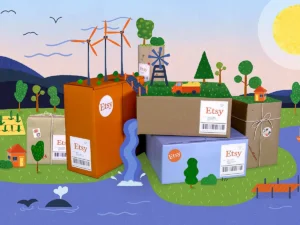While Earth Day brings our environmental responsibilities into sharp focus, the truth is, that sustainability demands our attention every single day. It’s about making conscious choices across all operations – from sourcing to packaging to the way we manage logistics. The aim is clear: build an ecosystem that’s beneficial for the planet, profitable for businesses and positive for consumers.
The market for green marketing is witnessing significant growth, projected to escalate from approximately $49.25 billion in 2021 to $60.81 billion by 2027, growing at an annual rate of 3.58%. This underscores a critical shift towards strategies that meet consumer demands while minimizing environmental harm.
So, ready to get your green on? Let’s dive into 5 ideas you can steer your business towards a greener future.
1. Eco-Friendly Packaging Solutions

Transitioning to sustainable packaging is one of the most direct ways to reduce your environmental footprint. Companies like Loop by TerraCycle have pioneered reusable packaging systems, offering products in containers that can be returned, cleaned and refilled. Meanwhile, Pela Case is revolutionizing ecommerce with 100% compostable phone cases, reducing plastic waste. Small changes, such as opting for recycled, biodegradable or compostable materials and minimizing packaging size, can significantly reduce waste and carbon emissions.
2. Sustainable Sourcing and Production

Prioritizing sustainability in sourcing and production processes is crucial. Similarly, Allbirds has innovated with materials like merino wool and sugarcane-based EVA for shoes, proving that sustainability can go hand-in-hand with quality and design. Businesses can audit their supply chains for environmental impact, invest in sustainable materials and champion transparency to build trust with consumers.
3. Carbon Neutral Shipping Options

Shipping contributes significantly to global carbon emissions, but there are ways to mitigate this impact. Etsy became the first major online shopping destination to offset 100% of carbon emissions from shipping, setting an industry standard. Your business can follow suit by offering carbon-neutral shipping options through partnerships with carbon offset programs, optimizing logistics to reduce emissions and encouraging customers to choose eco-friendly delivery options.
4. Recycling Programs

Implementing recycling programs not only demonstrates a commitment to sustainability but also directly engages customers in your environmental efforts. For example – Athleta recently hosted a swap, where customers could trade in any brand of leggings for a new pair of their Salutation Stash Tights. It was a hit in cities like NYC, Miami and Chicago, drawing in thousands. They not only shared their products with a larger base of customers but also committed to recycling or reselling the leggings they received, with profits helping out a women’s sports foundation. Even though this was a one-off event, Athleta is already deep into sustainability and resale with their Preloved program and their certification as a B corp company.
Other brands have solid recycling or resale programs, like Madewell which accepts old denim from any brand in exchange for $20 credit towards a pair of their jeans or the large number of brands who have partnered with popular online thrift store ThredUp to create resale programs.
5. Transparent Customer Engagement
Seventy-four percent of consumers indicated they are more likely to purchase from a company that is transparent about its sustainability practices (i.e., claiming carbon-neutrality, phasing out single-use plastics, using terms such as ‘eco’ or ‘biodegradable,’ etc.) and shares updates on progress toward sustainability goals frequently. Here are some companies who do that well:
- Patagonia’s “Footprint Chronicles”: Patagonia has set a benchmark for transparency with its “Footprint Chronicles” initiative. They offer an in-depth look at the supply chain of each product, detailing everything from the sourcing of materials to the environmental impact. This level of openness not only educates consumers but also holds Patagonia accountable for its sustainability claims, reinforcing consumer trust and loyalty.
- Lush Cosmetics’ Naked Packaging: Lush promotes its commitment to phasing out single-use plastics by offering a range of ‘naked’ or packaging-free products. They communicate the benefits and savings associated with these products directly to consumers, both in-store and online. By doing so, Lush not only reduces its environmental footprint but also engages customers in a dialogue about sustainable consumption, encouraging them to consider the impact of packaging on the environment.
By adopting even one of these ideas, companies can make a significant difference in reducing their environmental impact. Small changes, from switching to eco-friendly packaging to implementing energy-efficient operations, can lead to big impacts. Let’s commit to sustainability as a core principle of our business models, driving positive change for our planet and future generations.
Register for the 2024 CommerceNext Growth Show today to learn from 150+ industry-leading experts to further discuss sustainability through marketing practices!
FAQs:
1. How can small businesses with limited resources implement sustainable practices effectively?
Small businesses can explore options like starting with small, manageable changes, leveraging partnerships with suppliers for sustainable sourcing or seeking out grants or incentives for sustainability initiatives.
2. Are there any case studies or examples provided to illustrate the successful implementation of these sustainable shifts?
Patagonia is a retail brand that successfully implemented sustainable shifts.
What They Did:
- Supply Chain Transparency: Conducted audit, and identified areas for improvement.
- Sustainable Materials: Invested in research, used organic cotton, recycled polyester and hemp.
- Worn Wear Program: Encouraged repair, reuse and recycling of products.
- Environmental Advocacy: Supported environmental initiatives and campaigned for policy changes.
Success:
- Brand Loyalty: Built trust with environmentally conscious consumers.
- Competitive Advantage: Positioned as an industry leader.
- Financial Performance: Achieved sustainable revenue growth and profitability.
3. What are some potential challenges or barriers that businesses might encounter when trying to adopt these sustainable practices and how can they overcome them?
Businesses may encounter several challenges when adopting sustainable practices, such as initial investment costs, resistance to change from stakeholders or lack of knowledge and expertise in sustainable solutions. To address these obstacles, businesses can consider conducting thorough research, seeking guidance from sustainability experts or consultants and implementing gradual changes with clear goals and benchmarks for progress.
Related Posts
-
Unlock Your Year With AI: The Playbook for Ecommerce
In 2024, you have to make an impact with AI.…
-
Which Brand Launched Its Business Turnaround With an Apology?
Domino’s Did With Its “We’re Sorry For Sucking” Campaign In…
-
Elevate Your Ecommerce Business: The Ultimate Guide to the 2023 CommerceNext Ecommerce Conference
Ecommerce businesses are facing an ever-changing landscape and it's essential…




